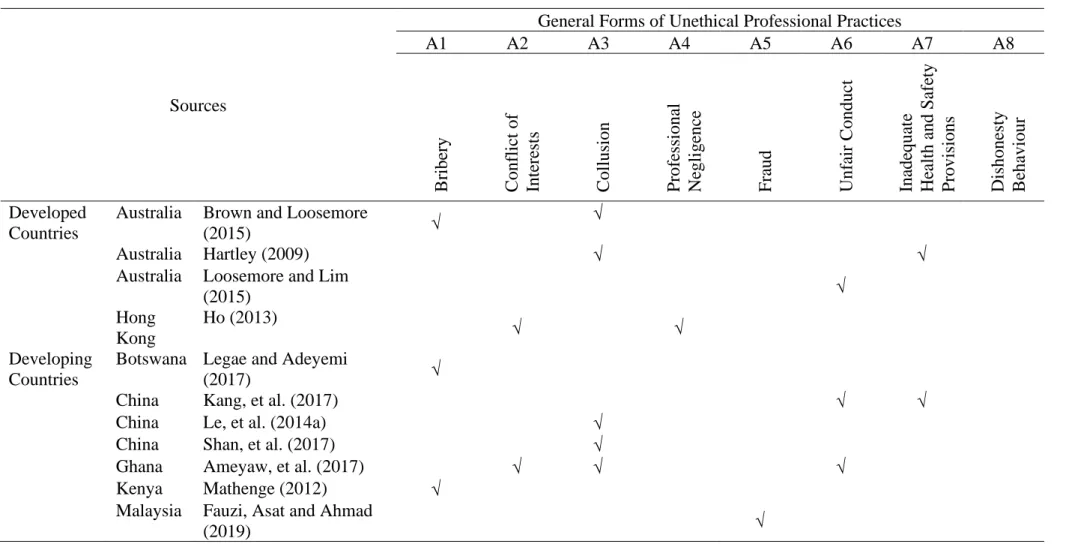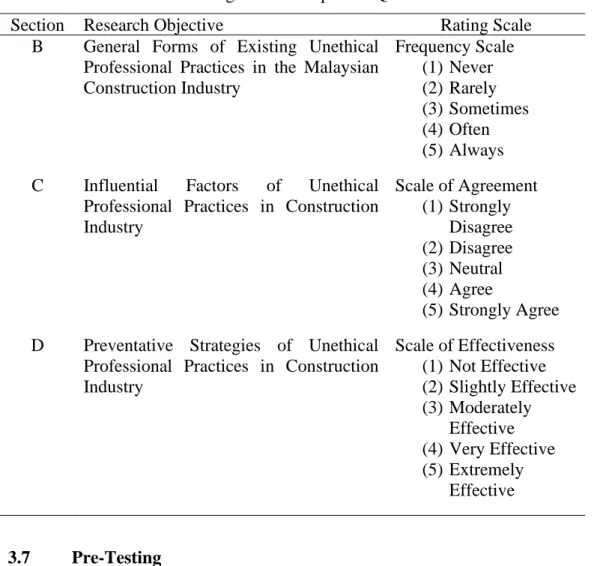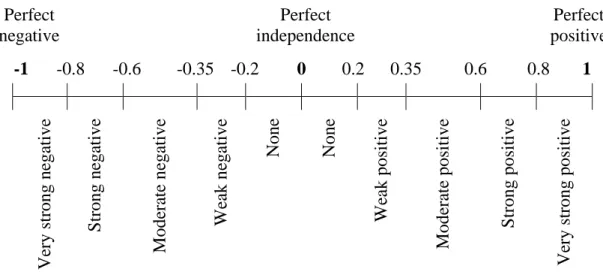Unethical professional practices in the Malaysian construction industry have posed serious problems in relation to building failures and national economy aspects. To achieve this goal, a comprehensive literature review was conducted that led to the identification of 8 types of unethical professional practices, 10 influential factors and 22 preventive strategies.
Background of Research
On the other hand, it is essential to consider the potential impact imposed on stakeholders such as the client, contractor, consultant and client against the background of the prevailing unethical professional practices in the construction industry. To achieve this, it is crucial to create understandings of the existing unethical professional practices in the construction industry and the respective preventive strategies that will be investigated and studied in this research.
Problem Statement
It is clear that unethical professional practices will destroy the construction industry which will further bring a ripple effect to the national economy. In light of this, developing countries such as Nigeria, Zambia, China, Saudi Arabia and Pakistan have played active roles in investigating the unethical professional practices in the construction industry, which is reviewed in Chapter 2.
Research Questions
Following the growing consensus that unethical professional practices in the Malaysian construction industry are common, but there have been limited adequate strategies in the current industry to alleviate this situation, this research aims to fill this gap and add to the existing literature by presenting a thorough overview of unethical professional practices in the construction industry and at the same time discover the respective preventive strategies.
Research Aim and Objectives
Research Scope
Significance of the Research
In summary, this research uncovers the existing unethical professional practices in the construction industry, together with the influential factors and corresponding preventive strategies, which will be crucial to strengthen the national economy, develop a good image of the construction industry and protect the interests of the construction parties.
Research Methodology
Organisation of the Thesis
Chapter 5, which is also the last chapter, contains the conclusion of this research, which summarizes the findings and concludes the entire research on unethical professional practices in the construction industry. In addition, this chapter discusses the implications of this research, along with limitations and recommendations for improving future research.
Introduction
Overview of Professional Ethics in Construction Industry
- Bribery
- Conflict of Interests
- Collusion
- Professional Negligence
- Fraud
- Unfair Conduct
- Inadequate Health and Safety Provisions
- Dishonesty Behaviour
- Summary of General Forms of Unethical Professional Practices A total of 8 types of unethical professional practices are identified from past
Despite being bound by a set of ethical rules, unethical professional practices are still prevalent in the construction industry. According to Kang et al. 2017), poor safety and risk assessment is not uncommon in the construction industry.
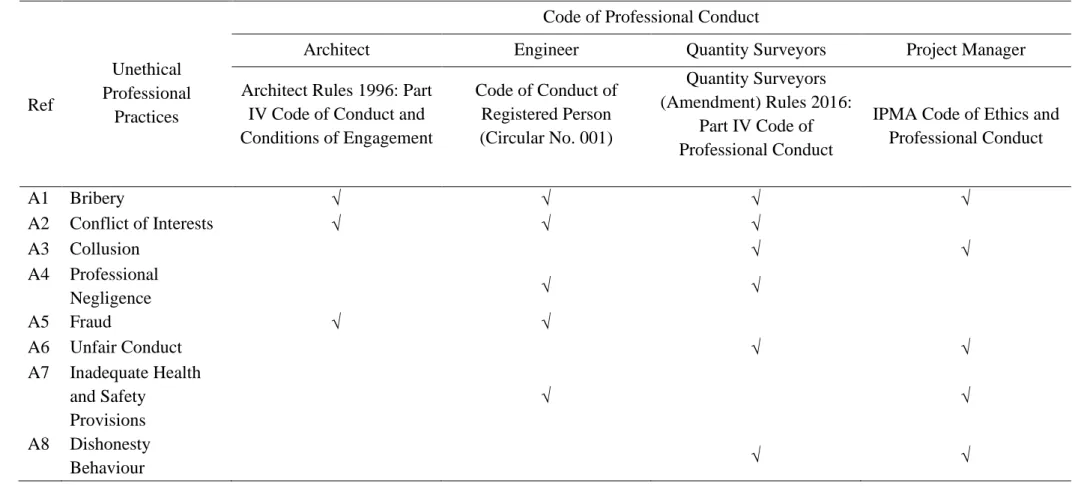
Impacts of Unethical Professional Practices in Construction Industry
A study conducted by Amoatey, et al. 2015) further discussed that the development of the construction industry is more likely to be affected against the backdrop of the prevalence of unethical behavior. In short, a total of 7 specific effects of unethical professional practices in the construction sector have been identified based on an extensive literature search.
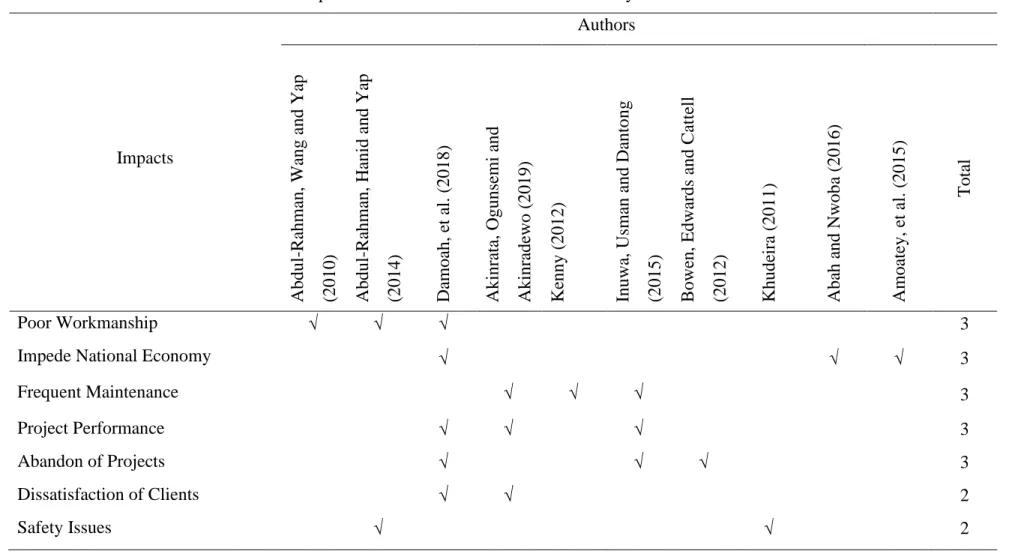
Influential Factors of Unethical Professional Practices in Construction Industry
- Lack of Supervision
- Intense Competition
- Lack of Ethical Standard and Ethical Code
- Social Ties among Different Parties
- Complex Nature of Project
- Economic Survival
- Flawed Regulations
- Project Uncertainties
- Negative Role Model
- Individual Financial Pressure
- Summary of Influential Factors of Unethical Professional Practices
Similarly, in China, it is revealed that the close relationships between contracting parties drive unethical professional practices (Zhang, et al., 2017). A comprehensive review of literature from different countries is done to explain the influential factors of unethical professional practices in the construction industry.
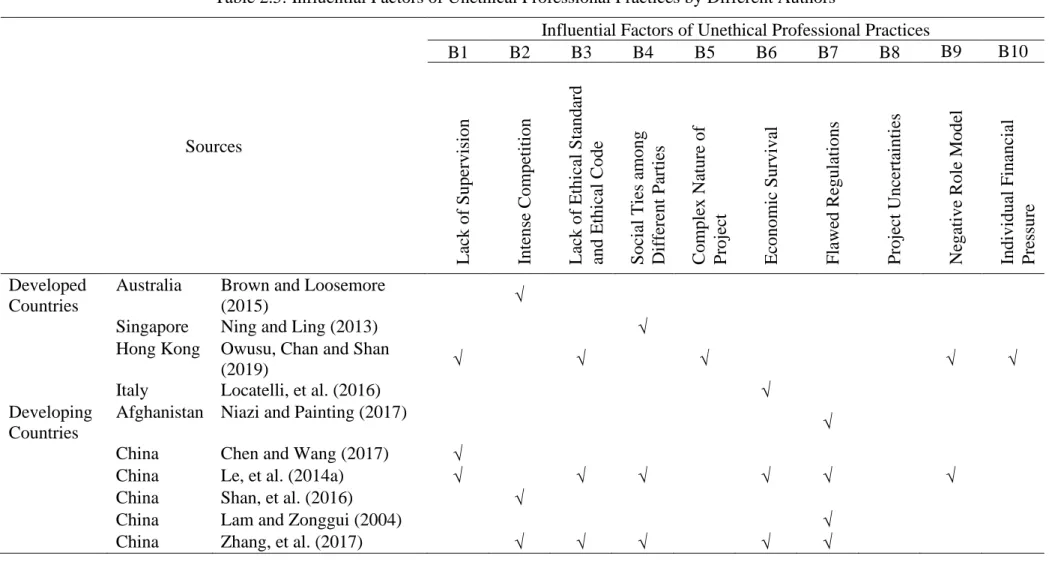
Preventative Strategies for Unethical Professional Practices in Construction Industry
- Managerial Measures .1 Transparency Mechanism
- Leadership
- Application of E-Procurement
- Institutional Accountability
- Disclosure of Vital Information
- Adequate and Prompt Payment of Professional’s Remuneration Professionals tend to involve in unethical professional practices if there is
- Checks and Balances
- Regulatory Measures .1 Code of Ethics
- Avoid Conflict of Interests
- Rules and Regulations
- Standards
- Probing Measures .1 Auditing System
- Whistleblowing Mechanism
- Rigorous Supervision
- Ombudsmen System
- Efficient Reporting System
- Quality Assurance Group
- Reactive Measures .1 Punishments
- Debarment and Blacklist
- Promotional Measures .1 Education
- Ethical Training
- Communication
- Summary of Preventative Strategies for Unethical Professional Practices
Construction stakeholders in the Hong Kong construction industry believed that improvement in institutional accountability would be one of the useful preventive strategies for unethical professional practices (Owusu, et al., 2020b). According to the study conducted by Owusu, et al. 2019), code of ethics is one of the most important strategies in combating unethical practices. Similarly, code of ethics (RGM1) should be supported by appropriate communication (PMM3) and reactive measures (RTM) (Ho, 2013; Olatunji, et al., 2016).
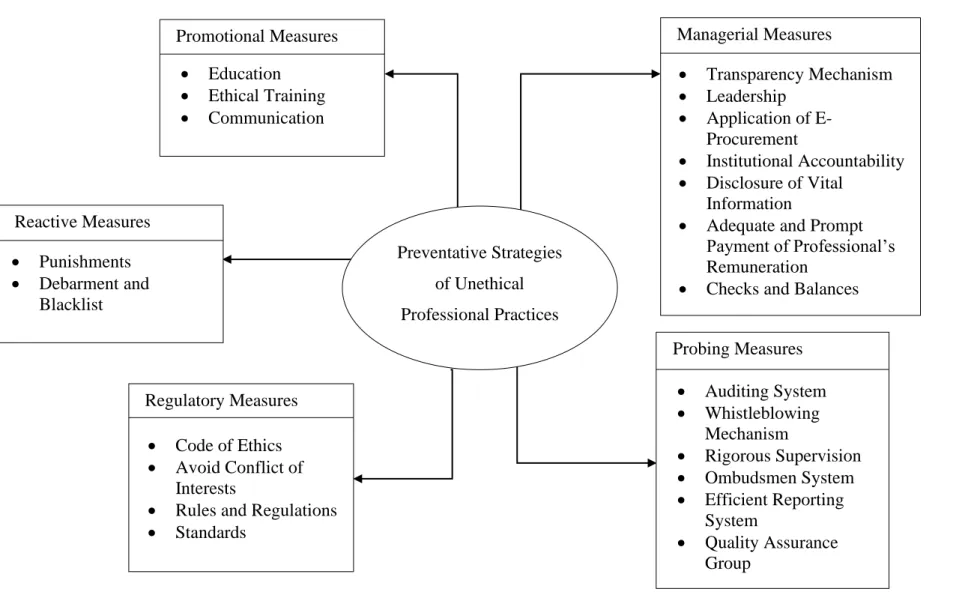
Summary
Introduction
Research Strategy
Research Design
Sampling Design
Targeted Respondents
The target respondents in this research focused on the main construction industry players in the construction industry. The research targeted construction practitioners from various organisations, including developer, consultant, contractor and government agency, with the aim of gaining a rich and balanced view of the research.
Sampling Size
Sampling Method
Convenience sampling refers to an unrestricted non-probability sample in which construction sites that are easy to approach were invited to participate in the questionnaire survey (Cooper and Schindler, 2014). In addition to convenience sampling, snowball sampling was undertaken at one point to request respondents to distribute the questionnaire to other construction practitioners willing to participate in the survey (Adams, Khan, & Raeside, 2014). Snowball sampling was chosen to obtain primary data from the respondents' referral network to achieve targeted sample size in a short period of time.
Data Collection Method
Therefore, considering the sensitivity of the research topic on unethical issues, the questionnaire is considered to be a suitable approach to measure people's perception of unethical issues. Fourth, the questionnaire offers anonymity and data confidentiality to the respondents, which is significant in light of the sensitivity of the research topic (Chan, et al., 2018; Owusu and Chan, 2018). Due to the Covid-19 restrictions, electronic questionnaire was selected to collect data from a large number of respondents who are geographically dispersed in Malaysia (Sekaran and Bougie, 2020).
Questionnaire
Prior to the development of the questionnaire, a thorough literature review was conducted to arrive at the variables of general forms, causes and strategies of unethical professional practice. Section B and Section C captured the existing forms of unethical professional practice and the influential factors in accordance with Objective 1 and Objective 2 respectively. On the other hand, Section D aims to collect primary data regarding Objective 3, which is to investigate the preventive strategies of unethical professional practice in the Malaysian construction industry.
Pre-Testing
Data Analysis Method
- Cronbach’s Alpha Reliability Test
- Shapiro-Wilk Test
- Mean Ranking
- Kruskal-Wallis Test
- Factor Analysis
- Spearman’s Correlation Test
A value of 0.05 from Shapiro-Wilk test indicates that the possibility that the actual data distribution differs from a comparable normal distribution is 5. This was used to group the variables into manageable sets of data so that the underlying structure of the variables could be studied (Cooper and Schindler, 2014; Fellows and Liu, 2015). The interpretation of values of the correlation coefficient is presented in Figure 3.2 (Hair, et al., 2013).
Summary
Correlation coefficient between -1 and +1 represents weaker negative and positive correlation, whereas a value of 0 indicates that the variables are completely independent (Saunders, Lewis, & Thornhill, 2016). In this research, Spearman's correlation test was used to examine the relationship between influential factors (objective 2) and preventive strategies (objective 3) of unethical professional practices in the construction industry. A total of six tests were conducted to analyze and evaluate the data, including Cronbach's alpha reliability test, Shapiro-Wilk test, mean rank, Kruskal-Wallis test, factor analysis, and Spearman's correlation test.
Introduction
Pre-Testing
On LinkedIn, a total of 158 valid responses were received out of 300 distributed, representing a response rate of 53. However, the overall response rate is considered reasonable and adequate in this research with some relevant justifications. First, low response rates are not entirely unexpected for web and email surveys (Fricker, 2008; Bowen, Edwards, & Cattell, 2015).

Profile of Respondents
The designation of the managerial position does not necessarily mean that the respondents have insufficient knowledge of the research topic. In fact, more than half of respondents (65%) have six years or more of work experience, suggesting that most of them are senior executives with significant years of experience and sufficient knowledge related to the research topic. In this regard, the respondents are considered sufficiently qualified to provide reliable evaluations on the subject of research (Zhang, et al., 2017; Yap, Lee, and Skitmore, 2020a).
Reliability of Results
Comparison with Previous Studies
The comparison with previous studies shows that the four main unethical behaviors occurring in Malaysia are also recognized in other developing countries. It is worth noting that bribery, one of the top four unethical professional practices, has been recognized in eight previous studies conducted in developing countries such as Saudi Arabia, Zambia, Ghana and South Africa. Although the current study focuses on Malaysia, the comparative analysis presented in Table 4.8 further confirms that the unethical professional practices identified may be an appropriate reflection of the unethical professional practices in the context of developing countries.
Kruskal-Wallis Test
Dishonest behavior is one of the unethical professional practices that occur in the construction industry. 2007) revealed that contractors tend to act dishonestly during interim valuation as they tend to demand too much. This is therefore reflected in the result, which ranks contractors dishonesty in 4th place among the eight variables. The competitiveness of the Malaysian local construction industry is highlighted by Rani, et al. 2021), who emphasized that the presence of foreign players in the local market gives rise.
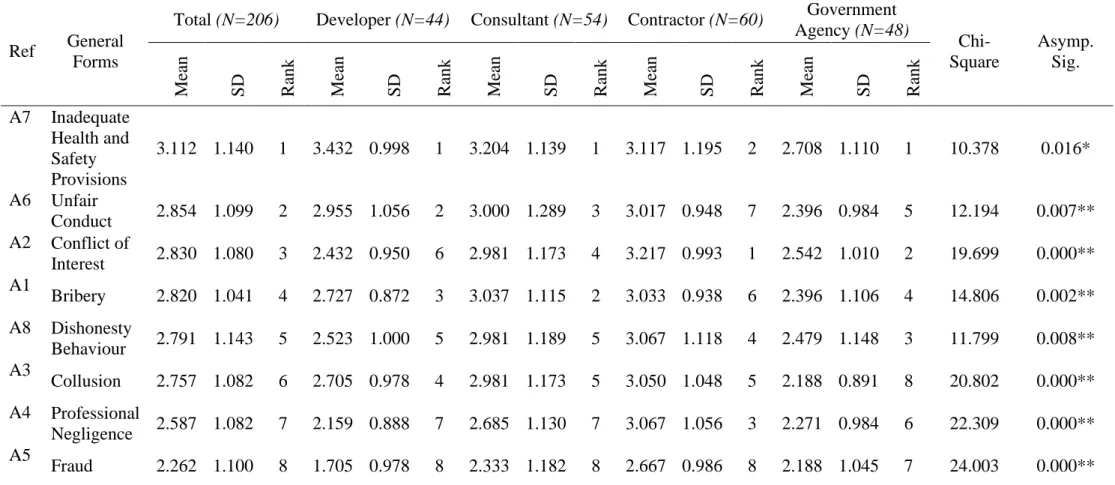
Comparison with Previous Studies
Social ties are in fifth place, indicating that the relationship between the parties in a project can influence the project implementation, as it can lead to unethical behavior. A similar case has been reported in India, where social ties between top management and civil servants are considered common for firms to survive in competition (Collins, Uhlenbruck, & Rodriguez, 2009). This is further justified by Yap, Lee, and Skitmore (2020), who believed that not all parties will have fair and equal opportunities in awarding tenders, as it is sometimes highly dependent on the quality of the social ties involved.
Kruskal-Wallis Test
In this regard, the results build on existing evidence of the key drivers that have led to unethical behavior and explain why the construction industry in developing countries is prone to unethical professional practices. In addition, exclusion and blacklisting are seen as one of the most effective strategies to combat unethical professional practices, ranked third by respondents. In addition, strict supervision is seen as one of the most effective strategies to curb unethical professional practices, ranked fifth by respondents.
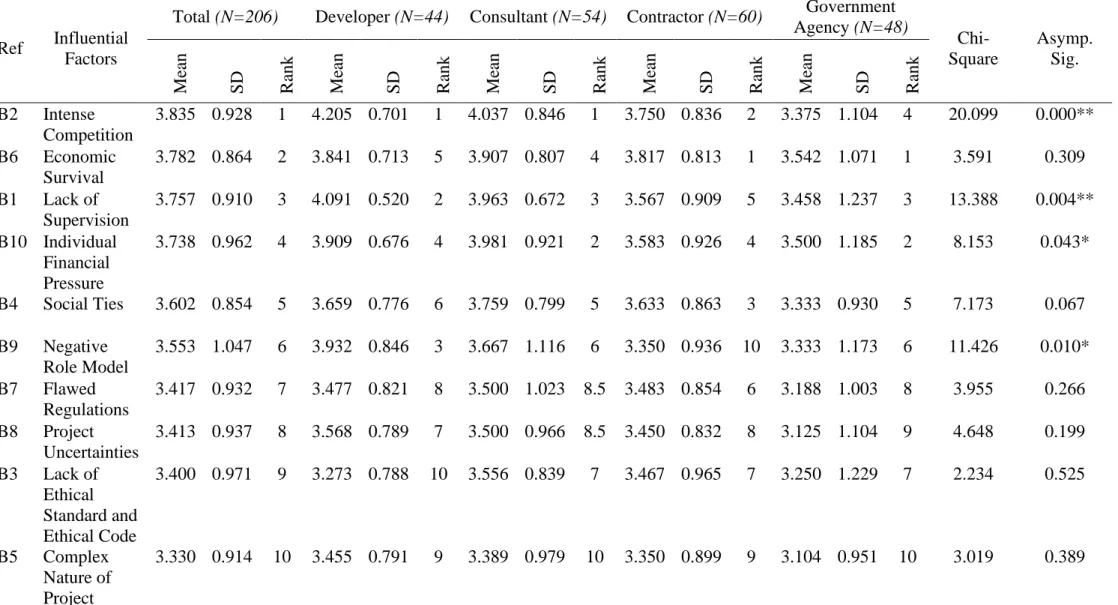
Comparison with Previous Studies
Checks and balances are ranked as the fourth most effective strategy to combat unethical professional practices with an average score of 3.971. Check and balance mechanisms are implemented by the Malaysian government to prevent abuse of procedures that regulate private entities. This is because quantity surveyors are particularly susceptible to unethical professional practices such as bribery.
Kruskal-Wallis Test
Furthermore, as shown in Table 4.13, the Bartlett's test of sphericity value is 0.000, indicating that the result is significant as it is less than the significant value of 0.05 (Pallant, 2013). Furthermore, as shown in Table 4.14, the five factors account for a total of 68.74% of the variance, which met the minimum criterion of 60% of the total explained variance (Norusis, 1992). The factor profile is shown in Table 4.14, with variables ranked in descending order based on factor loading.
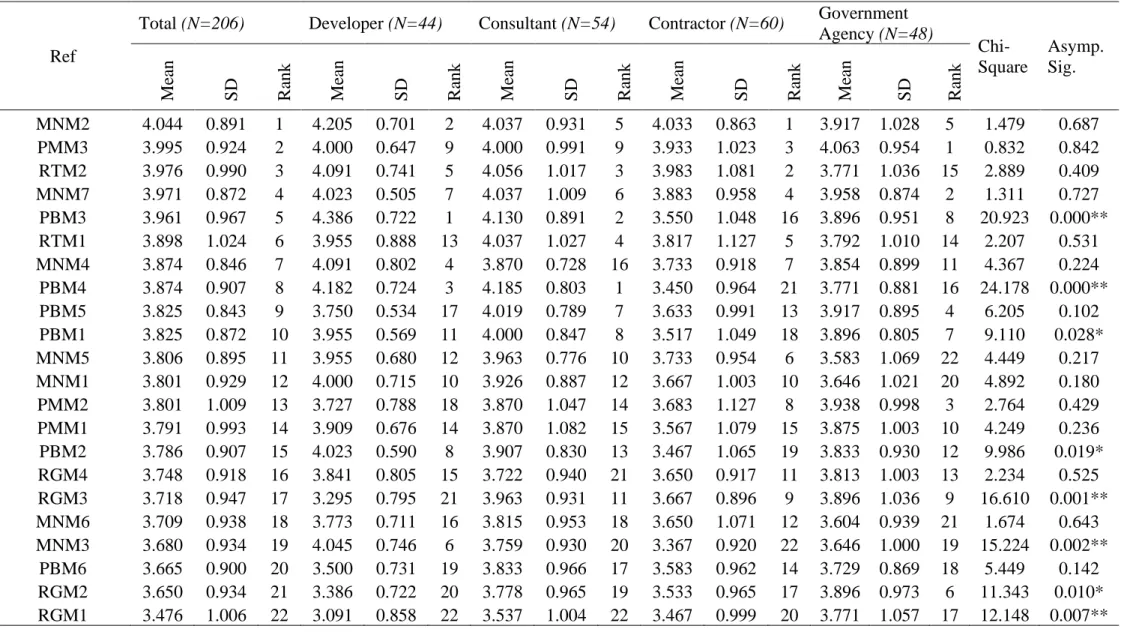
Extraction of Underlying Factors Factor 1: Managerial Construct
Professionals should declare any potential conflicts of interest prior to the start of the project (Adnan, et al., 2012). In addition, exclusion and blacklisting are also recognized as effective reactive measures to curb unethical behavior (Owusu, et al., 2020b). Consequently, it can potentially lead to quality issues for the project when there is unethical behavior at the delivery of the project (Damoah, et al., 2018).
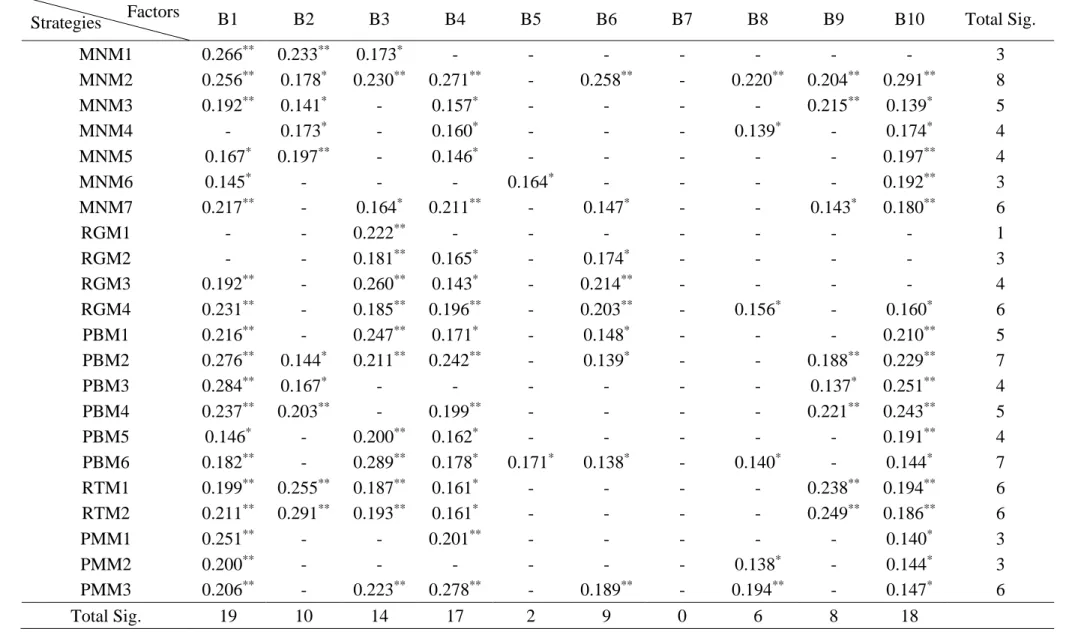
Summary
B1-Lack of supervision; B2-Intense Competition; B3-Lack of ethical standard and code of ethics; B4-Social ties; B5-Complex The nature of the project;. PBM1-Audit System; PBM2-Whistleblowing Mechanism; PBM3-Strict Supervision; PBM4-Ombudsmen System; PBM5-Effective reporting system;. Finally, Spearman's correlation test revealed three strategies with the most significant correlations, which were 'leadership', 'whistleblowing mechanism' and 'quality assurance group'.
Introduction
Conclusion
To answer this research question, respondents were asked to rate the level of frequency of various forms of unethical professional practices occurring in the construction industry. The result of the data analysis revealed that the most notable forms of unethical professional practices included inadequate health and safety provisions, dishonesty and conflict of interest. To answer this research question, respondents were asked to indicate their level of agreement with the influencing factors of unethical professional practices in the construction industry.
Research Implication
This research also examines the effectiveness of preventive strategies in reducing unethical behavior in the construction industry. Ethical Issues in the Construction Industry in Kenya: A Critical Analysis of Professional Behavior in Engineering Technology Management. For each statement, indicate one degree of agreement on influential factors of unethical professional practices in the construction industry.
